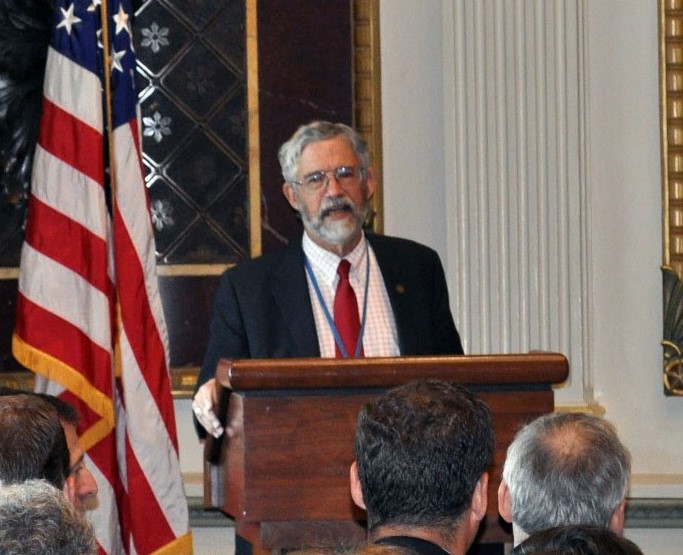Posted by Lloyd Whitman, Assistant Director for Nanotechnology at the White House Office of Science and Technology Policy, and Co-chair of the National Science and Technology Council, Committee on Technology, Subcommittee on Nanoscale Science, Engineering, and Technology (NSET).
 |
| Dr. John Holdren, Assistant to the President for Science and Technology, addresses White House Forum on Small Business Challenges to Commercializing Nanotechnology |
Over fifteen years ago, on January 21, 2000, President Clinton announced “a major new national nanotechnology initiative” that today we know as the National Nanotechnology Initiative (NNI). In his speech that day at CalTech, President Clinton said:
“Just imagine materials with 10 times the strength of steel and only a fraction of the weight; shrinking all the information at the Library of Congress into a device the size of a sugar cube; detecting cancerous tumors that are only a few cells in size. Some of these research goals will take 20 or more years to achieve. But that is why—precisely why—…there is such a critical role for the Federal government.”
In an interesting turn of history, on January 21, 2015—precisely 15 years later—President Obama visited Boise State University and saw some of the innovations brought forth by research in nanoscale science and technology, including DNA-based nanomanufacturing methods and new electronic materials. Following his visit, the President observed:
“Some of your faculty and students are working with next-generation materials like graphene, which is a material that’s thinner than paper and stronger than steel. It's amazing.”
The President’s remarks highlight the significant progress that has been made towards achieving the vision of the NNI: a future in which the ability to understand and control matter at the nanoscale leads to a revolution in technology and industry that benefits society. Over the last fifteen years, Federal agencies participating in the NNI have invested over 20 billion dollars in fundamental and applied nanotechnology R&D; world-class characterization, testing, and fabrication facilities; education and workforce development; and efforts directed at understanding and controlling the environmental, health, and safety (EHS) aspects of nanotechnology.
These investments are leading to an abundance of exciting outcomes. Nanotechnology is enabling a range of possibly revolutionary innovations for the future of electronics with two-dimensional materials like graphene, spin-based devices, and memristors—just to name a few. Advances in nanophotonics, including the direct integration of photonics with electronics, are opening up whole new approaches for computation, communications, and sensing. Many of the most promising developments in new energy technologies, including both generation and storage, involve nanostructured materials. New nanoparticle-based composites and additives that are coming to market or are already on the market offer dramatic improvements in properties such as strength-to-weight ratios, manufacturing complexity, lubrication, and catalytic efficiency. And finally, not a day goes by when there isn’t a significant announcement about advances in nanoparticle-based, targeted therapies for treating diseases like cancer.
But much remains to be done to fully realize the benefits of these advances, particularly when it comes to transitioning advances in R&D to commercial applications. A recent review of the NNI by the President’s Council of Advisors on Science and Technology (PCAST) concluded that,
“…the nanotechnology field is at a critical transition point and has entered its second era, which we call NNI 2.0. This next technological generation will see the evolution from nanoscale components to interdisciplinary nano‐systems and the movement from a foundational research‐based initiative to one that also provides the necessary focus to ensure rapid commercialization of nanotechnology.”
To make this “second era” of nanotechnology as successful as the first will require the entire “NNI 2.0” stakeholder community to work together in new ways. Success will require new collaboration and partnership activities – involving both the private and public sectors – aimed at collectively advancing manufacturing, entrepreneurship, and the development of a workforce with the needed skills.
Fortunately, the community is already rising to this challenge, with companies, government agencies, colleges and universities, and non-profits announcing a series of new and expanded public and private initiatives that complement the Administration’s efforts to accelerate the commercialization of nanotechnology and expand the nanotechnology workforce. Many of these activities were discussed on May 20, 2015 when the National Economic Council and the Office of Science and Technology Policy held a forum at the White House to discuss opportunities to accelerate the commercialization of nanotechnology.
 |
| Participants in White House Forum on Small Business Challenges to Commercializing Nanotechnology |
Overcoming barriers to manufacturing
- The Colleges of Nanoscale Science and Engineering (CNSE) at SUNY Polytechnic Institute in Albany, NY, are launching the Nano Health & Safety Consortium as an expansion of their partnership with the National Institute for Occupational Safety and Health (NIOSH). This partnership represents an expanded commitment by NIOSH and CNSE to work together to advance research and guidance for occupational safety and health in the nanoelectronics and other nanomanufacturing industry settings. The new consortium will be anchored at the CNSE campus in Albany and will ultimately extend across the full 10-campus SUNY Poly network in New York in order to best leverage the diverse research, manufacturing, and public-private partnership opportunities that exist.
- This month, Raytheon brought together a group of representatives from the defense industry and Department of Defense (DOD) to identify collaborative opportunities to advance nanotechnology product development, manufacturing, and supply-chain support. Working together on these points will also allow the DOD to optimize development, foster innovation, and take more rapid advantage of new commercial technologies.
- BASF Corporation, the world's largest producer and marketer of chemicals and related products, is a taking new approach to finding solutions to nanomanufacturing challenges. In March, BASF launched a prize-based “NanoChallenge” for methods to make ready-to-use inorganic nanoparticle dispersions to be applied in large area functional thin films. This approach is designed to drive new levels of collaborative innovation while connecting with potential partners to co-create solutions that address industry challenges.
- OCSiAl, a major producer of single-walled carbon nanotubes (SWCNT), in February of this year launched an award program to dramatically lower the cost of research and development aimed at commercializing and advancing nanotechnology with carbon nanomaterials. Through the program, the company has committed one metric ton of SWCNTs to be made available to universities and research institutions. Small samples are available for free, and award winners receive access to larger quantities of SWCNT materials at significantly reduced costs through a matching grant. Recognizing that commercial applications may not be apparent in earlier-stage research, OCSiAl is expanding its eligibility criteria for receiving SWCNTs to include more exploratory research proposals, especially proposals for projects that could result in the creation of startups and technology transfers.
Promoting the formation of new businesses or the success of early stage businesses.
- The NanoBusiness Commercialization Association (NanoBCA) is partnering with Venture for America and working with the National Science Foundation (NSF) to promote entrepreneurship in nanotechnology. Three companies (PEN, NanoMech, and SouthWest NanoTechnologies), are offering to support NSF’s Innovation Corps (I-Corps) program with mentorship for entrepreneurs-in-training and, along with three other companies (NanoViricides, mPhase Technologies, and Eikos), will partner with Venture for America to hire recent graduates into nanotechnology jobs, thereby strengthening new nanotech businesses while providing needed experience for future entrepreneurs.
- The National Nanotechnology Coordination Office (NNCO) is working with the small- and medium-sized business community in a series of publicly-available webinars to identify challenges and successes in the commercialization of nanotechnology and provide information from the public and private sectors to help address these challenges.
Developing a skilled workforce
- TechConnect, a global technology outreach and development organization, is establishing a Nano and Emerging Technologies Student Leaders Conference. This event will bring together the leaders of nanotechnology student groups, with an emphasis on undergraduates, from across the country and will include a research poster session, networking opportunities, and presentations from leading venture capitalists, entrepreneurs, and industry leaders. To provide maximum benefit to the students, the event will be co-located with the National SBIR/STTR Conference, the TechConnect World Innovation Conference & Expo, and the Nanotech Conference in May 2016. Five universities have already committed to partnering with TechConnect, led by the University of Virginia Nano and Emerging Technologies Club.
- Brewer Sciences, a small business and global leader in developing and manufacturing advanced materials and equipment for the fabrication of cutting-edge electronic devices, has developed a Global Intern Program to develop the high-skilled talent needed to continue the company’s growth. Each summer, the program provides more than 30 students (from high school to PhD) from across the country with hands-on experience in a wide range of functions within the company, from human resources to manufacturing engineering. Brewer expects to increase the number of its STEM interns by 50% next year, and is committed to sharing best practices with other nanotechnology businesses interested in how internship programs can contribute to a small company’s success.
- The National Institute of Standards and Technology’s Center for Nanoscale Science and Technology is expanding its partnership with the National Science Foundation (NSF) to provide hands-on experience for students in NSF’s Advanced Technology Education (ATE) program. With an emphasis on two-year colleges, the ATE program focuses on the education of technicians for the high-technology fields that drive our nation's economy. Following a successful summer pilot, the partnership will now run year-round and will include opportunities for students at Hudson Valley Community College and the University of the District of Columbia Community College. NIST is committing to share best practices with businesses and other laboratories interested in expanding hands-on training opportunities to build the future nanotechnology technical workforce.
- Federal agencies participating in the NNI, supported by the National Nanotechnology Coordination Office (NNCO), are launching multiple new activities aimed at educating students and the public about nanotechnology, including image and video contests highlighting student research, a new webinar series focused on providing nanotechnology information for K-12 teachers, and a searchable web portal on nano.gov of nanoscale science and engineering resources for teachers and professors.
As President Obama observed in his most recent State of the Union, “Twenty-first century businesses will rely on American science and technology, research and development.” We call on all sectors of the nanotechnology community to identify additional ways to work together and make sure more of those businesses are built on nanoscience and nanotechnology.


